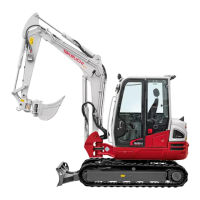5-55
5
TROUBLESHOOTING
SLEW MOTOR
SLEW MOTOR
If you notice that the noise or heat becomes unusually high, it is likely that there is a fault in the machine. If it occurs, stop
the machine immediately and try to locate the faulty section.
The table below shows the cause of the general problem and action to be taken when such problem occurs in the hydraulic
circuits.
Hydraulic motor, brake valve
Symptoms How/Where? Major causes Remedies
Motor fails to start •
No pressure at the motor’s inlet
port
•
Set pressure of relief valve is too
low
• Pump faulty
• Control valve faulty
• Set correctly
• Repair or replace
• Repair or replace
• There is pressure at the motor’s
inlet port
•
Load is too heavy
• Hydraulic motor is faulty
• Reduction gears are faulty
• Reduce the load
• Repair or replace
• Replace the reduc-
tion gears
Motor
does not
speed up
•
Pump discharge is insufficient • Too much drain from the pump • Repair or replace
the pump
• Functional problem of the motor • Drop in the motor’s volumetric ef-
ficiency
•
Replace the motor
Oil is leaking •
Leaking from an oil seal • Lip is faulty • Replace the oil seal
• Leaking from the mating surface • Bolts are loose
• O-ring is faulty
• Mating surface is scratched
• Retighten the bolts
• Replace
• Repair the surface
with a grindstone or
sand paper
Motor
produces
abnormal noise
•
Noise in the piping • Piping support is faulty • Clamp the piping
Temperature in-
cr
ease at the re-
duction gears
•
Lubricating oil • Oil level is low
• Hydraulic oil is entered
• Add oil
• Replace the reduc-
tion gears
• Gear unit • Bearings are damaged
• Gear surfaces are damaged
• Replace the reduc-
tion gears
•
Replace the reduc-
tion gears

